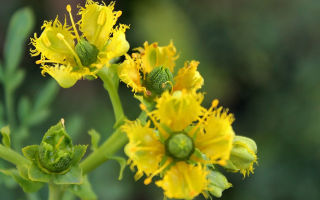Content
The healing properties of the rue plant have long been known among the people. The raw materials of this herb are successfully used to treat many diseases. Ruta has also found its way into cooking. The high healing properties of the plant are due to its rich chemical composition. It is used for the manufacture of some cosmetics.
The chemical composition of rue
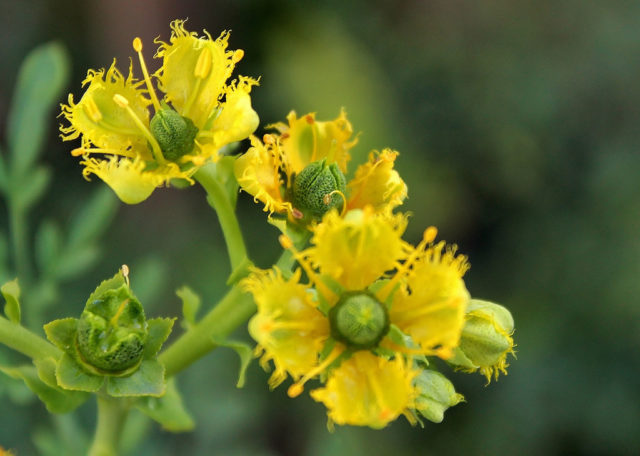
Fragrant rue is a perennial shrub. It grows up to 50 cm from a lignified rhizome. The stem of the plant is straight, leafy plates are green with a bluish tint. Flowering occurs in the summer. Flowers are collected in panicles. The fruit is an angular box with seeds.
The plant can be found on almost every continent - in Asia, in the north-east of Africa, in North and South America, the Mediterranean. Only one variety grows in Russia - fragrant, which is an annual shrub. Rarely in the country there is a vegetable lace maker from the Rutov family, which also has medicinal properties.
The plant is cultivated in plots as medicinal and ornamental in central and southern Russia. It is planted in a sunny place well protected from drafts. It is desirable that the soil is fertile and well fertilized. Ruta is propagated by seeds, which are sown in March. Landing in open ground is carried out in June at a distance of 30-40 cm from each other. Care consists in weeding, loosening the soil and timely feeding of the shrub.
Sheet plates contain:
- essential oils;
- tannins;
- resins;
- flavonoids;
- coumarins;
- alkaloids;
- graveoleonic acid;
- ascorbic acid;
- B vitamins;
- vitamin E.
The leaves contain essential oils - cineole, bergapten, santoxin, xanthotoxin and others. Alkaloids are found in fruits.
The benefits of rue
Fragrant rue has many positive qualities, but due to the high content of essential oils in the plant, it should be used with great care. The useful properties of the plant include:
- antiseptic;
- anti-inflammatory;
- absorbable;
- antitoxic;
- antispasmodic;
- diuretic;
- healing;
- stimulating;
- tonic effect.
Root harm
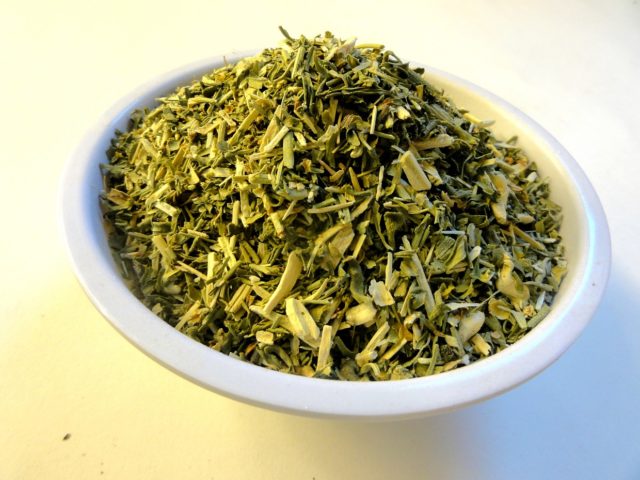
Experts consider the shrub to be a rather poisonous plant. When using raw materials for various purposes, one must be careful with concentration. By consuming large quantities of rue, you can involuntarily disrupt the work of many organs and systems - the stomach, liver, kidneys and blood vessels. There are known cases of intoxication, which were accompanied by a significant decrease in body temperature, slowing of the pulse, and sometimes fainting.
Despite its medicinal properties, fragrant rue is rather toxic. It should not be touched by hands, especially by children. On contact with the skin, it can cause swelling, redness and itching, burns, which appear in the form of watery blisters.
Contraindications to the herb rue
The healing properties of fragrant rue can have negative consequences for those who are prohibited from taking it as a medicine. The main contraindications include:
- childhood;
- During pregnancy and breastfeeding;
- uterine bleeding;
- menstruation;
- ulcers of the stomach and duodenum;
- chronic bowel disease;
- low blood pressure;
- violation of the level of acidity in the stomach.
It is not recommended to use the plant without a doctor's prescription. Treatment with means based on fragrant rue should be started gradually. Before use, you will need to consult a specialist who will help you calculate the dosage, the duration of the course of administration, the combination of the plant with concomitant diseases and other medications.
Rules for using rue
Many doctors are categorically against the use of scented rue for medicinal purposes, despite its healing properties. This is due to the same toxic qualities of the plant. With the wrong dosage, the substances contained in the rue will not only not solve the health problem, but will exacerbate it.
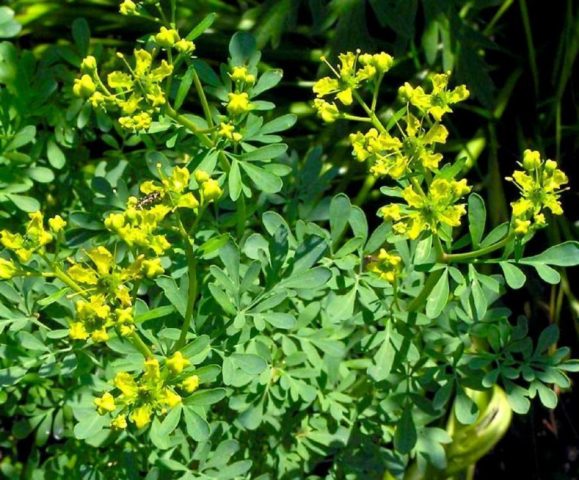
Before using raw materials as a medicine, you need to know how to properly prepare it, while maintaining all the healing properties. It is important to remember about the toxicity of the plant and prepare gloves in advance. Harvesting is usually done during the flowering period. The tops should be cut off, rinsed under running water and dried in the fresh air without exposure to direct sunlight. It is better to store in a tightly closed container in a dark, dry place.
Root application
In official medicine, drugs from fragrant rue raw materials are not used. According to the recipes of traditional medicine, ointments, infusions, tinctures and decoctions are made based on the plant. They are used for many diseases, since rue has a wide range of activity in pharmacology.
Due to its strong aroma, it is often used to repel insects. For this, the shrub is planted in those places where the appearance of pests is undesirable. The dried leaves can be stored in closets to prevent moths.
Ruta is used in cooking, using its seeds to make a mixture of herbs. Various marinades for meat dishes are prepared from them.
The use of fragrant rue in traditional medicine
The main ways of using the medicinal plant:
- Flowers help get rid of bronchial asthma. They are part of the infusions for this disease.
- Fragrant rue has an anthelmintic effect.
- It helps to get rid of flatulence, strengthens the stomach, and eliminates bad breath. It is often added to the composition of dental elixirs.
- When combined with vinegar and sage, the plant works well for fever and anemia.
- Fragrant rue helps to whet the appetite.
- With inflammation of the sciatic nerve and other back problems, fragrant rue with natural honey is used externally as a compress.
- In case of abscesses on the mucous membrane of the mouth, rinse with infusion is performed.
- Conjunctivitis is treated with rue, which is pre-brewed like tea. The resulting solution is washed with the mucous membrane of the eyes.
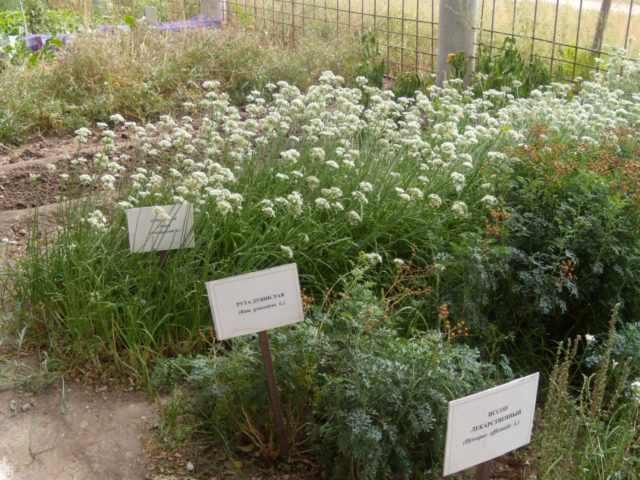
From rue, tinctures are made on wine, alcohol, vodka.
The use of rue in cooking
Even if the herb is well tolerated by the body, it should not be used in large quantities in cooking, as the smell and taste of the plant can overpower the qualities of the dish. The main uses in cooking:
- aromatization of tea drinks, compotes, cocktails, liqueurs, cognacs;
- marinades for canning cucumbers, tomatoes and other vegetables;
- sauces for meat and fish dishes;
- cooking spices;
- adding flavor to stews.
In some European countries, the plant is added to cheeses and curd products to add a piquant taste and aroma.
The use of rue as an ornamental plant
Many gardeners use shrubs not only for medicinal purposes, but also for arranging a curb on their site. To do this, plant seedlings are planted at intervals of 15 cm in a checkerboard pattern. The first year they are given the opportunity to grow freely. Starting from the second year, they are periodically pruned, forming an oval border. Full clearance ends in the fourth year, when the shrubs reach a certain size and density. After that, it is enough to periodically prune the plants to maintain a level surface.
Conclusion
The healing properties of the rue plant are beyond doubt. However, care must be taken when using raw materials from this shrub for medicinal purposes. The toxic properties of the plant cause concern among the representatives of traditional medicine.

